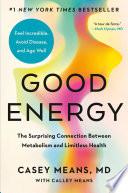

In 'Good Energy', the author emphasizes that managing energy, rather than time, is crucial for personal and professional success. This idea revolves around understanding that our energy levels fluctuate throughout the day and that aligning tasks with peak energy times can significantly enhance productivity. The concept encourages readers to recognize their own energy patterns and to structure their schedules accordingly. For instance, creative tasks may be best suited for morning hours when the mind is fresh, while analytical tasks can be tackled in the afternoon. The author provides practical strategies for energy management, such as taking regular breaks, practicing mindfulness, and engaging in physical activities to recharge. By prioritizing energy over time, individuals can work smarter, not harder, leading to increased efficiency and reduced burnout.
Continue readingThe book discusses the significance of cultivating positive energy in both personal and professional environments. Positive energy is depicted as a catalyst for collaboration, creativity, and overall workplace morale. The author illustrates how a positive mindset can influence team dynamics and productivity. Techniques for fostering positive energy include practicing gratitude, celebrating small wins, and creating an inclusive atmosphere where everyone feels valued. The narrative includes real-life examples of organizations that have successfully implemented these strategies, showcasing the tangible benefits of a positive energy culture. The idea stresses that when individuals and teams focus on positive energy, they can overcome challenges more effectively and innovate with greater ease.
Continue readingThe environment in which one operates plays a crucial role in energy levels according to 'Good Energy'. The author explores how physical spaces, social interactions, and even digital environments can either drain or enhance energy. For instance, cluttered workspaces may lead to distractions and decreased focus, while well-organized, aesthetically pleasing environments can boost creativity and motivation. The book encourages readers to assess their environments critically and make adjustments that promote positive energy. This includes decluttering workspaces, choosing uplifting colors, and fostering supportive relationships. The author provides actionable tips on how to create an energizing environment, both at home and in the workplace, emphasizing that a conducive environment is foundational to maintaining high energy levels.
Continue readingThe connection between energy and emotional intelligence (EI) is a key theme in 'Good Energy'. The author argues that understanding and managing one’s emotions, as well as empathizing with others, can significantly impact energy dynamics in teams. High EI individuals are better equipped to navigate conflicts, inspire others, and maintain a positive energy flow. The book offers insights into how to develop emotional intelligence through self-awareness, self-regulation, and social skills. Readers are encouraged to engage in reflective practices, such as journaling and seeking feedback, to enhance their EI. The narrative illustrates how leaders with high emotional intelligence can create environments that foster collaboration and innovation, ultimately leading to improved organizational performance.
Continue readingPhysical health is intricately linked to energy levels, as discussed in 'Good Energy'. The author highlights the importance of nutrition, exercise, and sleep in maintaining optimal energy. Poor dietary choices, lack of physical activity, and inadequate sleep can lead to fatigue and decreased productivity. The book provides practical advice on how to integrate healthy habits into daily routines, emphasizing that small changes can lead to significant improvements in energy levels. For example, the author suggests meal prepping for balanced nutrition, incorporating short exercise bursts throughout the day, and establishing a consistent sleep schedule. By prioritizing physical health, individuals can enhance their energy reserves, leading to better focus and performance at work.
Continue readingSetting boundaries is essential for protecting one’s energy, a concept that 'Good Energy' thoroughly explores. The author discusses how overcommitment and a lack of boundaries can lead to energy depletion and burnout. Readers are encouraged to assess their commitments and learn to say no when necessary, prioritizing tasks that align with their goals and values. The book provides strategies for establishing healthy boundaries, such as communicating clearly with colleagues and family, creating designated workspaces, and scheduling downtime. By setting boundaries, individuals can safeguard their energy, ensuring they have the capacity to engage fully in their most important endeavors.
Continue readingThe book concludes with a focus on harnessing collective energy in teams. The author argues that when individuals come together with a shared vision and purpose, their collective energy can lead to extraordinary outcomes. The narrative emphasizes the importance of teamwork, collaboration, and open communication in fostering a high-energy environment. Techniques for harnessing collective energy include team-building activities, open forums for idea sharing, and creating a sense of belonging among team members. The author provides case studies of successful teams that have leveraged their collective energy to overcome challenges and achieve remarkable results, reinforcing the idea that collaboration can amplify individual strengths.
Continue reading